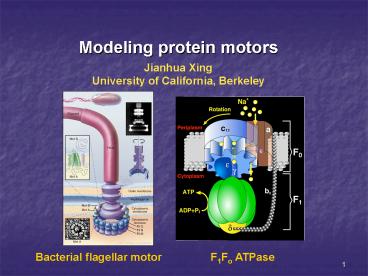Modeling protein motors - PowerPoint PPT Presentation
1 / 34
Title:
Modeling protein motors
Description:
Gabel, Berg (2003), PNAS, 100:8748-8751. Sowa et al. (2005), Nature, 437: ... Ryu, Berry, Berg (2000), Nature, 403:444-447. Low speed region: thermodynamic limit ... – PowerPoint PPT presentation
Number of Views:56
Avg rating:3.0/5.0
Title: Modeling protein motors
1
Modeling protein motors
Jianhua Xing University of California, Berkeley
F1Fo ATPase
Bacterial flagellar motor
2
Question 1 What are appropriate theoretical
and simulation frameworks?
A theoretical model should be
- Simple
- Not over-simplified
- Useful
3
- Atomic level simulations
- Provide atomic details
- Limited by system size and simulation length
- Require detailed structures
Kinetic models
4
I. General discussion
1. Molecular motors use chemical energy to
perform mechanical work
Occupied
Potential
Empty
Occupied state
Empty state
x
Chemical transitions switch the system from one
potential curve to another, and result in
mechanical motion
5
A generic molecular motor
Free energy
Angular position q
Keller, Bustamante (2000), Biophys. J., 78
541-556
6
II. The Bacteria Flagellar motor
1. Summary of experimental studies
H. Bergs website
7
a). Structure of bacterial flagellar motor
Vibrio alginolyticus
D. Thomas, N. Francis, and D. Derosier,
unpublished
EM image
8
The fuels trans-membrane ion motive force
9
b) Mechano-chemical studies
- The flagellar motor can
- Generate torque 2700 4000 pN.nm
- Rotate as fast as 1700 Hz
- (1 Hz 1 cycle/second)
Under viscous load
Under rotating electric field
Fung, Berg (1995), Nature, 375 809-812 Ryu,
Berry, Berg (2000), Nature, 403444-447 Chen,
Berg (2000), Biophys. J. 78 1036-1041 Gabel,
Berg (2003), PNAS, 1008748-8751 Sowa et al.
(2005), Nature, 437 916-919
10
c) The Puzzle
Linear decrease
Torque Constant
Speed ? pmf
Fung, Berg (1995), Nature, 375 809-812 Ryu,
Berry, Berg (2000), Nature, 403444-447 Chen,
Berg (2000), Biophys. J. 78 1036-1041 Gabel,
Berg (2003), PNAS, 1008748-8751
11
2. Our model
a) We proposed the working mechanism based on
available information
Xing, Bai, Berry , Oster (2005), submitted
12
b) We identified key ingredients from
experiments
The power stroke is driven by a conformational
transformation in the stator that is triggered by
the protons hopping onto and off the stator
Elastic coupling
Tight coupling
The rotation of the motor is observed through a
soft elastic linkage between the motor and the
viscous load
The ion channel through the stator is gated by
the motion of the rotor
Xing, Bai, Berry , Oster (2005), submitted
13
c) Mathematical modeling
Brownian Torque
Motor Torque
Markovian chemical transitions
Viscous Torque
Load Torque
Langevin
Fokker-Planck
Potential based kinetic model
Wang, Peskin, Elston (2003), J. Theor. Biol.
221491-511
Xing, Wang, Oster (2005), Biophys. J. 891551-1563
14
d) Our model can fit the data well
Xing, Bai, Berry, Oster (2005), submitted
15
3. Physical explanation of the torque-speed
relation
a) Plateau time scale separation soft
linkage
Spring constant
16
Crossover between the two time scales
17
Elastic linkage allows multiple time-scales
Conservative load
Viscous load with spring
Viscous load with rigid linkage
Xing, Bai, Berry, Oster (2005), submitted
18
b) Sharp transition positive feedback
19
c) Prediction
more stators ? more power
High speed region Destructive interference
Xing, Bai, Berry, Oster (2005), submitted
20
more stators ? more steps depends on relative
phases between stators
Free energy
Angular position q
2 stators
1 stator
21
d) The same physics explains other puzzles
Yasuda et al. (1998), Cell (93) 1117-1124
Mycoplasma causes diseases like pneumonia. Its
sliding rate depends on temperature linearly.
Miyata, Ryu, Berg (2002), J. Bacter., 1827-1131
22
4. Summary of flagellar motor
- The observed flagellar motor dynamics
is due to - Internal conformational change
- Soft elastic linkage between motor and load
- Tight coupling
- Localized chemical transitions
23
Mathematical modeling
Question 2 How to construct a mesoscopic model?
Fit data and suggest experiments
24
III. ATP synthesis with the F1Fo ATPase
1. the F1Fo ATPase
THE F1Fo ATPase
THE F1 PART
Fo model F1 model
Xing, et al. (2004), Biophys. J. 87 2148-2163
Xing, Liao, Oster (2005), PNAS, in press
25
2. The F1 part
Various experimental studies serve as the model
basis
Crystal structures
Single molecule measurements
Biochemistry measurements
Mutation studies
26
Constructing the potentials qualitative thinking
Berzborn, Schlittler (2002), FEBS Lett. 26828,
1-8 Ma, et al. (2002), Structure 10, 921-931
27
Constructing the potentials qualitative thinking
open
open
close
Rotation without synthesis
Correct sequence
Free energy G
ADPPi
ATP
ADP
Empty
200
300
0
100
Rotation angle degree
Xing, Liao, Oster (2005), PNAS, in press
28
Right timing/tight coupling is ensured by
specific b/g b/e interactions
Xing, Liao, Oster (2005), PNAS, in press
29
Reveal dynamic features without any calculation!
Free energy G
Xing, Liao, Oster (2005), PNAS, in press
30
The model can fit steady state ATP synthesis data
The model reveals multiple reaction pathways
Tomashek, JJ et al. (2004), J. Biol. Chem. 279
4465-4470 Xing, Liao, Oster (2005), PNAS, in press
31
3. Summary of the model on ATP synthesis
- Our model
- integrates a large body of experimental
observations - proposes a set of free energy potentials,
which contains - almost all dynamic information
- makes many experimentally testable predictions
32
IV. SUMMARY
Theoretical/Computational/Systems biology
require intimate collaboration between
experimentalists theoretician
- I have used molecular motor studies to show
that theoretical - modeling can
- Integrate and transform information
- Bridge structural and dynamical studies
- Predict dynamical behaviors
- Suggest new experiments
33
V. ACKNOWLEDGMENT
- George Oster
- Jung-Chi Liao
- Oleg Igoshin
- Andrew Spakowitz
- Oleksii Sliusarenko
- Jing Chen
- Joshua Adelman
- Hongyun Wang (UC Santa Cruz)
- Sean Sun (JHU)
- Richard Berry (Oxford)
- Fan Bai (Oxford)
- Peter Dimroth (ETH, Switzerland)
- Christoph v. Balmoos (ETH, Switzerland)
Financial support NIH
34
The End
35
(No Transcript)































